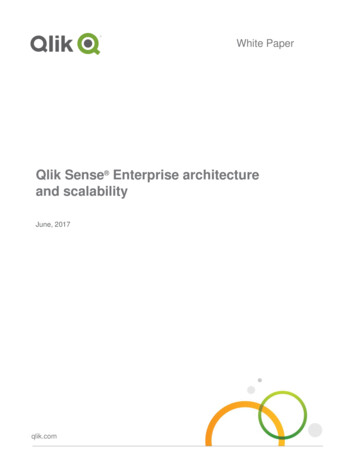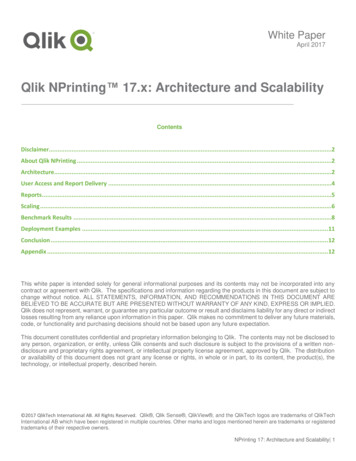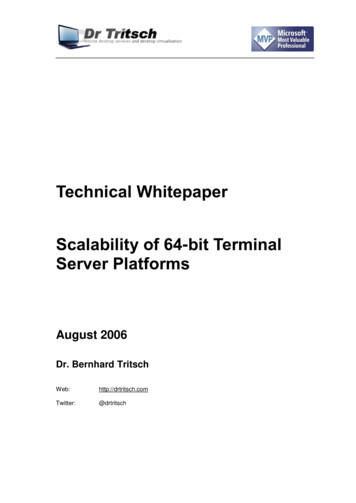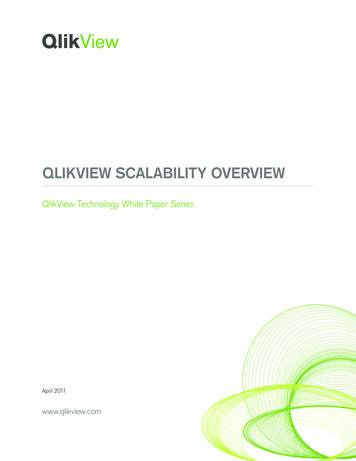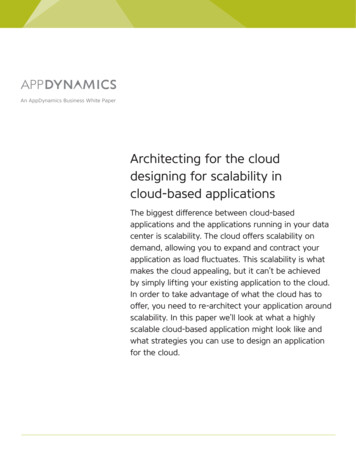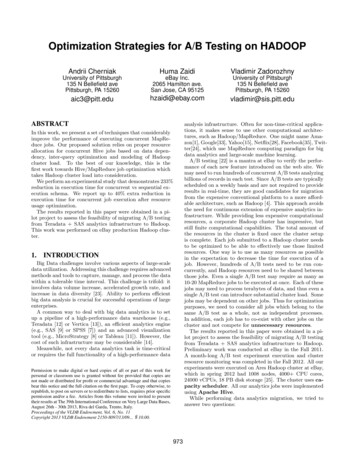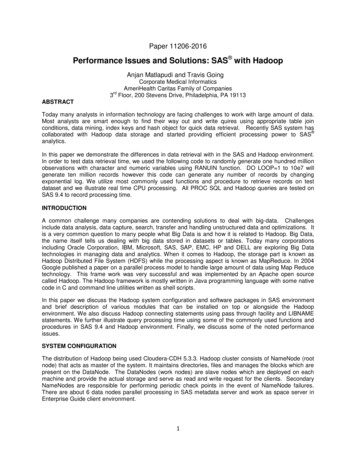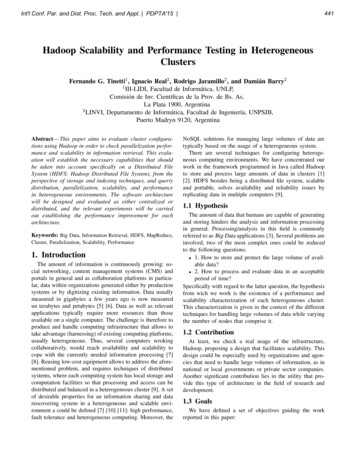
Transcription
Int'l Conf. Par. and Dist. Proc. Tech. and Appl. PDPTA'15 441Hadoop Scalability and Performance Testing in HeterogeneousClustersFernando G. Tinetti1 , Ignacio Real2 , Rodrigo Jaramillo2 , and Damián Barry21 III-LIDI, Facultad de Informática, UNLP,Comisión de Inv. Científicas de la Prov. de Bs. As.La Plata 1900, Argentina2 LINVI, Departamento de Informática, Facultad de Ingeniería, UNPSJB,Puerto Madryn 9120, ArgentinaAbstract— This paper aims to evaluate cluster configurations using Hadoop in order to check parallelization performance and scalability in information retrieval. This evaluation will establish the necessary capabilities that shouldbe taken into account specifically on a Distributed FileSystem (HDFS: Hadoop Distributed File System), from theperspective of storage and indexing techniques, and queriydistribution, parallelization, scalability, and performancein heterogeneous environments. The software architecturewill be designed and evaluated as either centralized ordistributed, and the relevant experiments will be carriedout establishing the performance improvement for eacharchitecture.Keywords: Big Data, Information Retrieval, HDFS, MapReduce,Cluster, Parallelization, Scalability, Performance1. IntroductionThe amount of information is continuously growing: social networking, content management systems (CMS) andportals in general and as collaboration platforms in particular, data within organizations generated either by productionsystems or by digitizing existing information. Data usuallymeasured in gigabytes a few years ago is now measuredun terabytes and petabytes [5] [6]. Data as well as relevantapplications typically require more resources than thoseavailable on a single computer. The challenge is therefore toproduce and handle computing infrastructure that allows totake advantage (harnessing) of existing computing platforms,usually heterogeneous. Thus, several computers wrokingcollaboratively, would reach availability and scalability tocope with the currently needed information processing [7][8]. Reusing low-cost equipment allows to address the aforementioned problem, and requires techniques of distributedsystems, where each computing system has local storage andcomputation facilities so that processing and access can bedistributed and balanced in a heterogeneous cluster [9]. A setof desirable properties for an information sharing and datareocovering system in a heterogeneous and scalable environment a could be defined [7] [10] [11]: high performance,fault tolerance and heterogeneous computing. Moreover, theNoSQL solutions for managing large volumes of data aretypically based on the usage of a heterogeneous system.There are several techniques for configuring heterogeneous computing environments. We have concentrated ourwork in the framework programmed in Java called Hadoopto store and process large amounts of data in clusters [1][2]. HDFS besides being a distributed file system, scalableand portable, solves availability and reliability issues byreplicating data in multiple computers [9].1.1 HypothesisThe amount of data that humans are capable of generatingand storing hinders the analysis and information processingin general. Processing/analysis in this field is commonlyreferred to as Big Data applications [3]. Several problems areinvolved, two of the most complex ones could be reducedto the following questions: 1. How to store and protect the large volume of available data? 2. How to process and evaluate data in an acceptableperiod of time?Specifically with regard to the latter question, the hypothesisfrom wich we work is the existence of a performance andscalability characterization of each heterogeneous cluster.This characterization is given in the context of the differenttechniques for handling large volumes of data while varyingthe number of nodes that comprise it.1.2 ContributionAt least, we check a real usage of the infrastructure,Hadoop, proposing a design that facilitates scalability. Thisdesign could be especially used by organizations and agencies that need to handle large volumes of information, as innational or local governments or private sector companies.Another significant contribution lies in the utility that provide this type of architecture in the field of research anddevelopment.1.3 GoalsWe have defined a set of objectives guiding the workreported in this paper:
442Int'l Conf. Par. and Dist. Proc. Tech. and Appl. PDPTA'15 1) Design different scalable architectures for a Hadoopcluster varying the number of nodes in order to analyzeprocessing time.2) Select bibliographic material and generate a knowledge based on the techniques and methods used inpartitioning, replication, and distribution in the ApacheHadoop infrastructure.3) Set parameters and evaluate different architectures foroptimizing Hadoop configuration.2. HadoopHadoop is a framework that allows to build a clusterarchitecture, providing parallel recovery of information andreplication. Also, Hadoop implement a simple way to addand/or drop cluster nodes, improving scalability, minimizingthe likelihood of failure nodes containing distributed data.Developed in the Java programming language, by the community of free software Apache, the Hadoop architecture iscomposed of three main components: The Hadoop Distributed File SystemHDFS, using amaster/slave architecture, as shown in Fig. 1. The MapReduce framework, which allows the programmer to split and parallelize complex calculations in anynumber of computers. The Hadoop Common, a set of tools for integratingHadoop subprojects.designed to analyze large amounts of structured and unstructured data.2.1 Hadoop DFSHDFS implements a master/slave architecture as shownin Fig. 2, where: a) NameNode is the master process, b)DataNodes are the slave processes, and c) the master processis replicated in a Secondary NameNode. The HDFS keepsseparately metadata (in the NameNode) and data (in theDataNodes). System (data) reliability is achieved by replicating files in multiple DataNodes, which also allows fastertransfer rates and access. All files stored in HDFS systemare divided into blocks, whose size usually is between 64MB and 128 MB. A Hadoop cluster can consist of thou-Fig. 2: HDFS ArchitectureFig. 1: Hadoop ArchitectureThe two main components, the HDFS and MapReduce,define a stable, robust, and flexible framework for distributedapplications, making it possible to work with multiple nodesand process large amounts of information.The HDFS is designed to provide high performanceand data reliability on heterogeneous hardware. MapReduceallows the development of parallel processing applications,focused on scalability. Queries on distributed data could bedistributed as well, thus enhancing performance via parallel/distributed processing. Both (HDFS-MapReduce) aresands DataNodes wich respond to different read and writerequests from clients, also maintaining block replication. TheDataNodes regularly send information to the NameNode ofits blocks to validate consistency with other DataNodes. Acluster may consist of thousands of DataNodes, each ofwhich stores a portion of (possibly replicated) data. Each ofthe DataNodes is likely to fail. The HDFS provides rapid andautomatic failover recovery via replication and the metadatacontained in the NameNode.During normal operation the DataNode sends signals(heartbeats) to NameNode every three seconds by default.If the NameNode does not receive a defined number of theheartbeats from a DataNode, the DataNode is considered outof service. Then the NameNode triggers the creation of newreplicas of the DataNode out of service in other (not failing)DataNodes. Heartbeats also contain information about thetotal storage capacity, the fraction of storage that is in use,and the number of files or data transfer in progress.
Int'l Conf. Par. and Dist. Proc. Tech. and Appl. PDPTA'15 2.2 Hadoop MapReduceMapReduce allows Hadoop the parallel processing onlarge volumes of data through multiple nodes in a cluster,the data to be processed may be stored in the HDFS. Theexecution of a MapReduce process usually divides the inputdata into a set of independent chunks of information that areprocessed by the Map tasks in parallel. Then, the results ofthe map tasks are classified and will be the input to Reducetasks. Typically both the input data and output data are storedin the file system.MapReduce is based on the Master/Slave architecture,similar to that of the HDFS, as shown in Fig. 3. The Masterruns the so called JobTracker and slaves run the TaskTrackers. The JobTracker is responsible for the managementand control of all sumitted jobs. Also, it is responsible fortask distribution and management of available TaskTrackers,trying to keep the job as close to the data as possible. TheJobTracker takes into account the machines (nodes) that areclose to and/or contain the data needed.4433. Design and Implementation of ExperimentsDifferent cluster configurations were evaluated from thepoint of view of scalability and (raw) performance. We alsoused two benchmarks, each used for measuring different performance metrics. Hardware and benchmarks are describedin the following subsections.3.1 Computers-HardwareWe specifically focused our work on heterogeneous computing cluster configurations, using the computers detailedbelow:1) Name: MasterProcessor: Intel(R) Core(TM) i5-2400 CPU @3.10GHzMemory: 10 GBSATA Disk: 500 GB2) Name: Slave1Processor: Intel(R) Core(TM) i7-2600 CPU @3.40GHzMemory: 16 GBSATA Disk: 500 GB3) Name: Slave2Processor: Intel(R) Core(TM) i7-2600 CPU @3.40GHzMemory: 8 GBSDisk: 1 TB4) Name: Slave3Processor: Intel(R) Core(TM) i3 CPU 540 @ 3.07GHzMemory: 8 GBSATA Disk: 1TBFig. 3: MapReduce ArchitectureMapReduce is based on key/value pairs, which are processed in (are the input to) Map tasks. Every Map taskreturns a list of pairs in a different domain data. All thepairs (generated by the Map tasks) with the same key aregrouped and processed by a Reduce task.MapReduce handles fault tolerance in a similar way to thatdescribed for the HDFS: each TaskTracker process reportsregularly its status to the JobTracker process. If over aperiod of time the JobTracker process has not received anyreport from a TaskTracker process, the TaskTracker processis considered as not running. In case of failure, the task isreassigned to a different TaskTraker process.The computers were used for different testing scenarios: acentralized one and three cluster-like installations. Initially,the Master was used as a standalone centralized Hadoopinstallation, including a Master and a DataNode. We willuse this installation as the departure point for testing theHadoop software as well as measuring a non-distributedenvironment. The different cluster installations (from 1 to4 computers) were made up just taking advantage of theprevious installation by adding one more computer includingone more DataNode. The same number of Map and Reducetasks per node is maintained in all the experiments.The Hadoop client process (which is not part of themain Hadoop infrastucture shown in Fig. 1 before) in everyexperiment was run on Name: ClientProcessor:AMD Turion(tm) X2 Dual-Core MobileMemory: 4 GB
444Int'l Conf. Par. and Dist. Proc. Tech. and Appl. PDPTA'15 SATA Disk: 320 GB3.2 Benchmarks-SoftwareWe used two well-known tests provided by the Hadoopsoftware: TestDFSIO and TeraSort. TestDFSIO is aimed atassessing the performance of the cluster/Hadoop installationand TeraSort is focused on scalability and parallelization.The Hadoop TestDFSIO benchmark is used for readingand writing files in the HDFS, indicating number and size offiles. TestDFSIO provides timing information, performance,and the average I/O speed. Basically, TerstDFSIO is usefulfor: Measurement tasks such as stress tests on HDFS. Discovering bottlenecks in the network. Evaluating the hardware performance. Checking the operating system configuration andHadoop cluster machines in general.In short, TestDFSIO gives a first impression of how fast thecluster works in terms of I/O. This test runs MapReduce jobsit is a MapReduce program that reads/writes random datafrom large files. Each Map task performs the same operationin a separate file and informs speed to a Reduce task, whichis programmed to collect and summarize all measurements,given in MB/seg.The Hadoop Terasort benchmark is designed to assessthe performance and scalability of a Hadoop installation. Itis specifically designed to check the distrubution of processesin the cluster using Map Reduce. TeraSort execution actuallyinvolves the execution of three MapReduce programs:TeraGen for data generationTeraSort for sorting the generated dataTeraValidate for sorted data validationThe TeraGen program writes data to disk just liketestDFSIO-write creates random data. TeraSort sorting performance is based on the way that divides data betweenmappers/reducers and how data is collected and written bythe partitioner. A partitioner is implemented for achievinga balanced workload. The partitioner uses an ordered listof N-1 sample keys that define the range of keys for eachReduce. In particular, a key is sent to the i-th Reduce ifit resides within a range such that sample[i-1] key sample[i], this ensures that the ith Reduce output is less thanthe output of the (i 1)-th Reduce. The TeraValidate programensures that the output is globally sorted out by controlling(in the output data) that each key is less than or equal to theprevious one.4. ResultsA TestDFSIO preliminary test was carried out for assesingHadoop I/O performance of different cluster configurations.This test was run increasing from 1 to 14 the number of filesof size 1 GB each (i.e. from 1 to 14 GB). Cluster architecturewas also increased from 1 to 4 nodes, as shown in Fig. 4.Read operation results were taken into account for this run,with default settings, which imply BufferSize: 1000000 bytes Replication factor: 3 Number of tasks in parallel by node: 2 Block size: 64 MBFig. 4: TestDFSIO Read PerformanceFig. 4 shows how the performance decreases as the numberof files (and involved data) increases, due to several factorsamong wich we can mention network traffic, local diskaccesses, etc. Results are labelled as 1.4 Nodes fromthe standalone case to the complete cluster, with 4 nodes(computers) running the experiment. It is worth mentioningthat heterogeneity does not play an important role and isalmost negligible. However, when using the 4 computers (4Nodes), performance is slightly penalized as compared tothe case in which only 3 computers (3 Nodes) are used forthe 14 files.TeraSort results are the ones we are really interested in,because parallel computing is directly involved. Data to besorted has to be generated, and we chose to follow theFibonacci sequence 107 . Therefore:7 In the first run 1 10 records or rows are generated,where each row is 100 bytes in size.77777 2 10 , 3 10 , 5 10 , 8 10 and 13 10 recordsare then generated.i.e. from 10 to 130 millions of records to be sorted. Andgiven that each record is 100 bytes long, the total amount ofdata is among 1 GB to 13 GB. For each cluster configuration(from a standalone Master to the complete 4 nodes cluster),TeraGen was first executed to generate the data serie. Once
Int'l Conf. Par. and Dist. Proc. Tech. and Appl. PDPTA'15 the data is generated, TeraSort is run in set of 10 identicalexperiments and the average runtime is taken as the result,just to avoid transient experiment “noise”. Finally TeraValidate was run to confirm that the data were actually sorted.For each test configuration TeraGen was first executed togenerate the first data series, and TeraSort was run in asequence of 10 repetitions, thereby strengthen the statisticalresults and obtain representative values. TeraValidate wasalways used to confirm that the data were actually sorted.Table 1 shows measured runtime for each experiment, i.e.varying the number of computers mand the amount of data445a numeric point of view. We have to continue ourexperiments (at least) in that line of work.Fig. 5 shows the values of Table 1 graphically, focusedon experiments runtime (on the vertical axis) depending onthe amount of data to be sorted (on the horizontal axis).Some scalability details can be identified in Fig. 5, sinceTable 1: Summary of TeraSort Results1 GB2 GB3 GB5 GB8 GB13 GB1 Node71114247577104223862 Nodes8014821037388518883 Nodes6811316925850410984 Nodes81102163210316574Fig. 5: TeraSort Scalabilityto be sorted, where “1 Node” represents the standaloneconfiguration (only the Master node is running), “2 Nodes”represents the configuration with the master and Slave1running, and son on. There are several interesting detailswhich can be quantified with the values shown in Table 1: A larger amount of data to be sorted implies increasingthe runtime, as could be expected a priori.For small size data sets (e.g. 1 GB or 2 GB) using morecomputers does not imply a performance improvement.More specifically, the runtime using the Master andSlave1 increases the runtime for 1 GB and 2 GB datato be sorted.For large size data sets (e.g. 8 GB or 13 GB) using morecomputers always imply a performance improvement.The improvement depends on several factors such ascentralized to distributed (1 Node and 2 Nodes), orwhere the added computer is relatively less powerfullthan those already running in the cluster (3 Nodes and4 Nodes, the 4th node is the least powerfull one in thecluster).For intermediate size data sets of those experimentedwith (e.g. 3 GB and 5 GB) gains are difficult to evaluate,and some more specific experiments should be carriedout even with other benchmark/s.Given that Hadoop is expected to handle TB of information, all of the results could be considered highlyencouraging, since even handling small size data sets itis possible to obtain performance gains using heterogenous computers.Some results regarding performance enhancements arelinearly related, while others not. Relative computingpower of each node has not been calculated, so thevalues cannot be strictically analyzed/evaluated fromscaling (increasing) data clearly implies increased runtime.At this time, it should be recalled that sorting is an O(n2 )problem in general. Also, Fig. 5 clearly shows that increasingthe number of nodes in a cluster the runtime is reducedusing Hadoop with the proper configuration of HDFS andMapReduce.5. ConclusionsEven when we have several problems in the Hadoopinstallation and configuration stages (mainly due to lack ofdocumentation at the time we began this research some yearsago) we have set a successful environment for experimentation with Hadoop in heterogeneous clusters. The installationand configuration could be replicated in every cluster (eitherhomogeneous or heterogenous).We have used TestDFSIO as a departure point: HadoopI/O performance. Furthermore, we have found that TestDFSIO does not provide any information about parallel computing and/or scalability. At most, TestDFSIO could be used fornode failure experimentation, varying the replication factorand injecting node failures in different scenarios.We have used TeraSort for performance analysis in general, and performance scalability in particular. At this point,the MapReduce programming model and its conceptual basisare the most relevant. We have analyzed the processesinvolved in a Hadoop job so that we were able to determinethe correct amount of Map and Reduce tasks per node and toproperly configure MapReduce parameters. Our experimentsshow that processing times decreases as the cluster nodesare added. Clearly, MapReduce does not solve everything,is a solution for those problems that fit the model and can beparallelized. One of the important results of experimentation
446Int'l Conf. Par. and Dist. Proc. Tech. and Appl. PDPTA'15 is that having small size data sets to process (maybe upto 5 GB specifically for sorting) would suggest to avoidMapReduce at all (
Hadoop Scalability and Performance Testing in Heterogeneous Clusters Fernando G. Tinetti1, Ignacio Real 2, Rodrigo Jaramillo2, and Damián Barry 1III-LIDI, Facultad de Informática,

